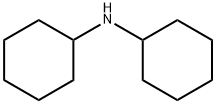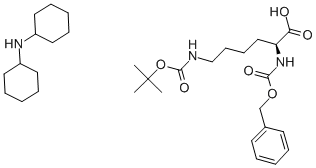Dicyclohexylamine , 99% , 101-83-7
Synonym(s):
DCHA;Dicyclohexylamine
CAS NO.:101-83-7
Empirical Formula: C12H23N
Molecular Weight: 181.32
MDL number: MFCD00011658
EINECS: 202-980-7
PRODUCT Properties
| Melting point: | -2 °C |
| Boiling point: | 256 °C |
| Density | 0.912 g/mL at 20 °C(lit.) |
| vapor density | 6 (vs air) |
| vapor pressure | 12 mm Hg ( 37.7 °C) |
| refractive index | n |
| Flash point: | 205 °F |
| storage temp. | Store below +30°C. |
| solubility | organic solvents: soluble |
| form | Crystalline Powder |
| pka | 10.4(at 25℃) |
| color | White to off-white |
| PH | 11 (1g/l, H2O, 20℃) |
| Odor | amine odor |
| explosive limit | 0.8-4.6%(V) |
| Water Solubility | 1 g/L (20 ºC) |
| FreezingPoint | -2℃ |
| Sensitive | Air Sensitive |
| Merck | 14,3095 |
| BRN | 605923 |
| Stability: | Stable. Incompatible with strong acids, strong oxidizing agents. |
| InChIKey | XBPCUCUWBYBCDP-UHFFFAOYSA-N |
| LogP | 2.724 at 25℃ |
| CAS DataBase Reference | 101-83-7(CAS DataBase Reference) |
| NIST Chemistry Reference | Cyclohexanamine, N-cyclohexyl-(101-83-7) |
| EPA Substance Registry System | Dicyclohexylamine (101-83-7) |
Description and Uses
Dicyclohexylamine is a combustible, colorlessliquid with a faint amine odor. Molecular weight=181.36;Boiling point=256℃; Flash point $99℃. HazardIdentification (based on NFPA-704 M Rating System): Health3, Flammability 1, Reactivity 0. Slightly soluble in water.
Dicyclohexylamine is manufactured by reacting equimolar quantities of cyclohexanone and cyclohexylamine or cyclohexanone and ammonia. It is used as a solvent and in organic syntheses. It is reportedly used as a chemical intermediate for the synthesis of corrosion inhibitors, rubber vulcanization accelerators, textiles, and varnishes.
Safety
| Symbol(GHS) |    GHS05,GHS06,GHS09 |
| Signal word | Danger |
| Hazard statements | H301+H311-H314-H410 |
| Precautionary statements | P270-P273-P280-P303+P361+P353-P304+P340+P310-P305+P351+P338 |
| Hazard Codes | C,N |
| Risk Statements | 22-34-50/53-24/25 |
| Safety Statements | 26-36/37/39-45-60-61 |
| RIDADR | UN 2565 8/PG 3 |
| WGK Germany | 2 |
| RTECS | HY4025000 |
| F | 8-9-23 |
| Autoignition Temperature | 240 °C |
| TSCA | Yes |
| HazardClass | 8 |
| PackingGroup | III |
| HS Code | 29213000 |
| Hazardous Substances Data | 101-83-7(Hazardous Substances Data) |


![N-[(1-[1,1-biphenyl]-4-ylisopropyloxycarbonyl]glycine, compound with N-dicyclohexylamine (1:1)](https://img.chemicalbook.com/CAS/GIF/18701-38-7.gif)
